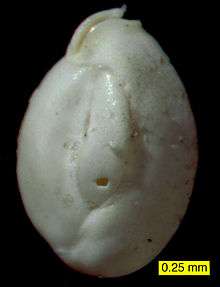Miliolida
| Miliolida Temporal range: Carboniferous - Recent | |
|---|---|
 | |
| Quinqueloculina sp. from Donegal Bay, Ireland. | |
| Scientific classification | |
| Domain: | Eukaryota |
| (unranked): | SAR |
| (unranked): | Rhizaria |
| Phylum: | Retaria |
| Subphylum: | Foraminifera |
| Class: | Tubothalamea |
| Order: | Miliolida |
| Superfamilies | |
|
Cornuspiracea | |
The Miliolida are an order of foraminifera with calcareous, porcelacous tests that are imperforate and commonly have a pseudochitinous lining.[1] Tests are composed of randomly oriented calcite needles that have a high proportion of magnesium along with organic material. Tests lack pores and generally have multiple chambers.
Miliolids, which range from the Carboniferous to recent, are benthic Foraminifera abundant in shallow waters such as in estuaries and along coastlines, though they also include deepwater oceanic forms.[2]
The order Miliolida, sometimes referred to as a suborder, the Miliolina, is divided on the basis of differences in test morphology into five recognized superfamilies.
References
- ↑ Loeblich, Alfred R.; Tappan, Helen (1964). Moore, R.C., ed. Protista 2: Sarcodina Chiefly "Thecamoebians" and Foraminiferida. Treatise on Invertebrate Paleontology. C (5th ed.). Geological Society of America. pp. 436–510a. ISBN 978-0-8137-3003-5.
- ↑ Omaña, L., Alencaster, G., Buitrón, B.E., (2016). "Mid-early late Albian foraminiferal assemblage from the El Abra Formation in the El Madroño locality, eastern Valles–San Luis Potosí Platform, Mexico: Paleoenvironmental and paleobiogeographical significance" (PDF). Boletín de la Sociedad Geológica Mexicana. 68: 477–492.
- Pictures of Smaller Miliolids. USF. Retrieved 2009-09-01.
External links

This article is issued from
Wikipedia.
The text is licensed under Creative Commons - Attribution - Sharealike.
Additional terms may apply for the media files.